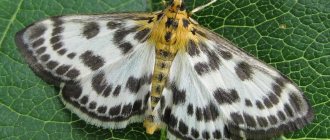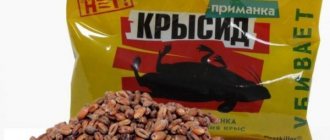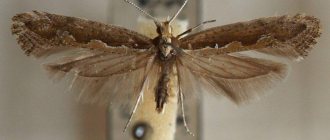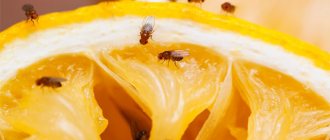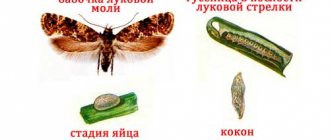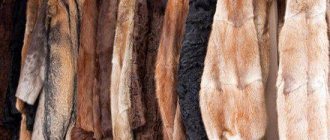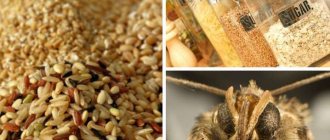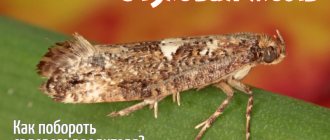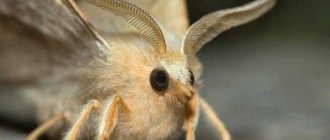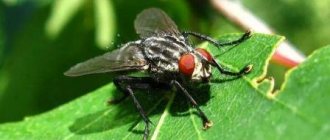Often, spots resembling patterns form on the leaves of trees and shrubs. The chestnut leaf takes on a unique pattern, as if it had been hit by mines. The reason for their appearance is caused by the negative impact of a pest such as chestnut moth. Officially, its name sounds like Ohrid miner, but in common people it is sometimes simply called chestnut. This type of insect pest was first identified in 1985 near Lake Ohrid in Macedonia, hence the name. Now the chestnut moth is found in Russia and affects not only chestnuts, but also plane trees and maples.
A little about the chestnut moth
The chestnut leaf miner is a voracious and therefore dangerous insect that prefers chestnut (green mass of leaves) and related trees as food.
It received the name “miner” because of its characteristic feature of laying eggs in inconspicuous passages hidden in the thickness of the leaf. Such passages, which are made by insect pests, are called “mines” by botanists. The caterpillar of this pest bites into the pulp of the leaf and massively damages it, thereby causing irreparable damage to the tree. Its presence can be determined in the spring by the cloud of small, inconspicuous moths swarming over the trees. Their size can be judged by the fact that with a full wingspan they reach a centimeter. A swarming cloud means that the chestnut moth is celebrating the mating season en masse: the moths are looking for a mate, then the fertilized female lays eggs, after which the larvae hatch and the entire development cycle repeats.
In the photo, this pest is harmless and even some may find it attractive due to its terracotta-red color. But foresters, green farm workers and botanists can give a long lecture about the damage these cute creatures cause to green spaces and how difficult it is to fight them.
The chestnut miner, like most insect pests of wildlife, undergoes cyclical changes in its activity: after a two-year active cycle, when caterpillars destroy entire plantings, a 3-4-year lull occurs, but for those who care about the health of trees, this is not enough comfort. It takes many years for a chestnut seedling to grow into an adult tree, and if control measures are not taken, the chestnut moth will devour the young trees.
One clutch of chestnut moth contains an average of 50 eggs. After a maximum of 3 days, a larva hatches from the egg - a whitish worm. At this stage, the moth can neither be detected nor therefore killed: it is reliably covered by the leaf in which it is located and on which it feeds.
The first, second and third stages of development of the chestnut moth are the growth and development of the larva “at home”, in the mined passage. The microscopic worm can only feed on chestnut juice and is not strong enough to actively move into the depths of the greenery. But as it grows, the course begins to gradually grow deeper.
At the fourth stage, the larva finally turns into a caterpillar, which needs increased nutrition. The entire fifth stage is a frantic devouring of fiber and green mass. It is often at this stage that the moth is noticed. And at this time, you can still save, if not the tree itself, which is covered with insects, then at least the surrounding trees.
The chestnut leaf miner caterpillar needs to grow to enter its sixth and final stage as a healthy insect with an adequate supply of nutrients. This is necessary so that the caterpillar pupates safely before turning into an adult. The closer the pupal phase, the thicker and more phlegmatic the chestnut miner. She loses interest in food because her task is to spin the thread with which she will wrap herself in a cocoon. It is interesting that the caterpillars of this pest do not always do such work; sometimes they are content with cocoons from which moths have already hatched, climb into them and there they transform into a sexually mature individual.
The chestnut moth butterfly makes a hole in the cocoon and climbs out. This happens at the time when flowering clusters appear on the chestnut tree.
Reproduction
The time of egg laying of the chestnut moth is easy to notice: during this period they hover in huge numbers around the chestnut tree. One individual is capable of laying about 50 eggs in one clutch. The larvae hatch in just a few days and directly from the eggs penetrate into the thickness of the chestnut leaf. The larva is isolated from the environment, since the entrance hole is blocked by an egg - a mine.
The development of the chestnut moth larva occurs in stages:
- The first three of them she grows and gains weight. At this time, it feeds only on juice and begins to make its way;
- The fourth stage is transformation into a caterpillar. From this moment, fiber nutrition and active expansion of living space begin;
- The fifth stage is the same caterpillar gaining mass;
- By the sixth stage, it stops feeding and spins thread for the cocoon.
After this, the insect pupates. The pupa metamorphoses into an adult, emerging into the light along with the chestnut blossom.
What does the chestnut leaf miner look like?
The Ohrid miner was first recorded only 30 years ago in Macedonia, when this insect pest was considered a relict Balkan species. From a small range in Greece and the Balkan Peninsula, this moth has captured the whole of Europe and is actively moving to the East.
Regardless of theories of origin and whether the Ohrid miner was introduced from East Asia and North America or is native to Europe, catastrophic climate change has caused the once-only-in-the-south pest to spread even into Scandinavia.
The Ohrid miner is a small butterfly with a body length of up to 7 mm and a wingspan of up to 10 mm. This moth miner has a very decorative mottled pattern on its reddish forewings and black dots on its legs.
One female chestnut leaf miner can lay more than 80 eggs. The butterfly's eggs are so tiny that they are almost impossible to notice with the naked eye. They are scattered along the front side of the leaf, near the veins.
Caterpillars go through 6 instars with radically different forms of nutrition and lifestyle. They are also inconspicuous: their size varies from less than 1 mm at the beginning of development to just over 2 mm in the third stage and the “final” 5-6 mm.
The greatest damage is caused by caterpillars in the first five phases - from feeding only on plant sap to switching to eating the tissues of chestnut leaves themselves. Only at the sixth age do they begin to spin and pupate. The pupae of the chestnut leaf miner do not exceed 0.5 cm in length.
This is the most aggressive of all leafminer moth species. For the entire embryonic period, this butterfly needs from 4 days to 3 weeks. The development of the caterpillar takes no more than 45 days in the most unfavorable conditions. In one season during the warm months, Ohrid miners can give birth to three offspring. And no other pest destroys the foliage of ornamental trees as quickly as the Ohrid miner.
Plants affected by chestnut leaf miner
Despite its name, the chestnut leaf miner does not affect only chestnut trees, and it does not spread equally to all horse chestnut trees.
The Ohrid miner is the main pest of white-flowering horse chestnuts, in particular common and Japanese. Compact hybrids suffer greatly from it, the degree of resistance of which varies depending on the conditions and characteristics of selection.
Certain varieties of horse chestnut are unattractive or even destructive to this species of butterfly. Thus, on Chinese, Californian, meat-red, Indian, Assamese, and small-flowered horse chestnuts, the caterpillars die in the early stages of development.
Choosing the right species and checking resistance to Ohrid miner for a specific plant when purchasing is the best solution. After all, vulnerable varieties and species have more and more resistant competitors every year.
In addition to chestnuts, the Ohrid miner is also found on several ornamental species of trees and vines:
- five-leaf maiden grapes;
- decorative maples, especially white and Norway maples.
One effective method of creating an unfavorable environment for chestnut leaf miners is to install “insect hotels.” ©Wudwerx
Description and appearance
The pest received its name from the geographical location of the area in which these insects were first discovered in the 1980s - the vicinity of Lake Ohrid in Macedonia. The first description of the leaf miner was made by local biologists G. Deshka and N. Dimic.
Initially, the pest was considered a relict Balkan species, but gradually the moth spread northward throughout Europe, from Croatia, Austria (1989), Germany (1994) to the Scandinavian countries (2002) and even to the UK. In Russia, the chestnut moth annually affects trees in the Central regions (since 2005) and the Kaliningrad region (since 2003). According to census estimates, the rate of spread of the pest in some countries reached 100 km/year.
An adult Ohrid miner looks like a small butterfly - the body length is 7 mm, the wingspan is up to 10 mm. The body is brown, the front wings are distinguished by a bright motley pattern and white lines on a brown-red background, the hind wings are light gray. White paws are decorated with black dots. The insect was called a leaf miner because of its ability to make passages (mines) in leaves.
Scientists classify the chestnut leaf miner as a member of the moth family, which is a species of butterfly that can invade the territory of other species. The development cycle of the pest consists of a two-year active period, when the caterpillars emerging from eggs are capable of destroying large areas of planted trees. Then follows 3-4 years of calm.
Development
One of the main features of the development of the chestnut leaf miner and other species of the family is hypermetamorphosis - a method of development in which caterpillars of different ages differ sharply; The caterpillar goes through six phases of development, while the caterpillars of the first - third instars differ from the caterpillars of the fourth and fifth instars in their lifestyle and nutrition, which, in turn, is reflected in their external differences. In the sixth phase of development, the caterpillars spin silk and do not feed.
Caterpillars of the first three phases of development feed only on plant sap (therefore this stage is called the “sap phase”) and form mines in the epidermal layer of the leaf or directly under the skin. Caterpillars of the fourth and fifth phases move from feeding on cell sap to feeding on the tissues themselves of the upper part of the mesophyll of the leaf (the so-called “tissue-eating phase”), while forming more spacious and deeper mines in the leaf. The body of these caterpillars becomes more or less cylindrical, and they acquire well-developed thoracic and abdominal legs. Their head becomes semi-prognathic and their mouthparts are well developed. Caterpillars in the sixth phase of development do not feed (the “non-feeding phase”), but spin silk to build a cocoon. Caterpillars at this stage of development are distinguished by a reduced oral apparatus, a well-developed spinning apparatus and a more fusiform body shape. For 20-45 days, depending on climate and season. According to Gerasimov A.M. (1952), in the genus Camereria
within the sixth phase, two ages are distinguished: in the first, the caterpillars make the lining of the cocoon, in the second - its inner part; Moreover, caterpillars ready to pupate are able to colonize cocoons of previous generations.
Having emerged from the eggs, the first instar caterpillars penetrate under the cuticle into the epidermal layer of the leaf of the host plant. There they begin to absorb the juice, usually making a straight, slightly curved passage along the vein. This passage in the epidermal part is silvery in color, 0.7-1.5 mm long and 0.3-0.5 mm wide. The excrement of the caterpillar in this section of the mine shows a black central line on it (0.05 mm wide at the beginning and 0.08 at the end), which is formed by sections connected by spots. Then the caterpillar forms a spot-like mine with a diameter of 1 mm in the epidermal layer of the leaf, where it begins to molt. At this point, the line of excrement forms a spot-like part of an irregular spherical shape. Sometimes the mottled part of the mine is pale brown. Caterpillars that form such mines can already begin to feed on the juice of the cells of the upper layer of plastid parenchyma.
Caterpillars of the second instar completely switch to feeding on the cell sap of the leaf of the host plant. By the end of the second instar, the larvae form a round mine with a diameter of 2-3 mm. Third instar caterpillars still feed on cell sap in the upper layer of the palisade parenchyma. First, the caterpillars expand the mines in a circle, with excrement completely covering the bottom of the mine, forming concentric black circles. Round mine with a diameter of 6-8 mm, dark. At the fourth instar, the caterpillars switch from feeding on sap to feeding on tissues of all layers of the palisade parenchyma. The average length of the mine is already 16 mm. At the fifth instar, the caterpillars continue to feed on tissues. The mine is from 18 to 31 mm long and from 6-8 to 12-14 mm wide. Sixth instar caterpillars do not feed at all. They first clear the site of exuviae and head capsules of previous instars to build a cocoon and get down to business.
In nature, adult insects appear at the very beginning of chestnut flowering and the appearance of petals. Butterflies hatch (appear) from pupae mainly in the first half of the day. In the afternoon there are single cases of hatching: 52.
Reproduction
Each female chestnut leaf miner lays 20-80 green eggs with a diameter of 0.2-0.3 mm during its life. On one leaf plate on the front side there may be several dozen eggs laid by different females. After 4-21 days (the speed depends on the ambient temperature), larvae emerge from them in the form of white worms, which penetrate deep into the layers of the leaf plate, moving along the veins, and feed on plant sap. The passages formed by the caterpillars are silver in color and up to 1.5 mm long.
The development of the caterpillar goes through 6 phases over 30-45 days and as it grows, its size increases to 5.5 mm. It has a light yellow or greenish body covered with hairs. At the last stage, the caterpillar stops feeding and begins spinning and building a cocoon.
At the next stage, the caterpillar turns into a pupa, which is covered with hairs and has curved hooks on its abdomen. Such devices help it hold on to the edges of the mine, protruding from the leaf, which happens before the butterfly flies out.
Caterpillar of the Chestnut moth.
Nutrition
Insects feed on plant leaves, and the variety is so great that it boggles the imagination. Even conifers are amazed by their miners. Below are lists, far from complete, of quarantine objects, for example, trees:
- horse chestnut;
- Linden;
- holly;
- sycamore;
- Rowan;
- poplar;
- thuja;
- juniper;
- Apple tree;
- cherry;
- citrus.
Shrubs:
- rose;
- rose hip;
- hawthorn;
- honeysuckle;
- spirea.
Herbaceous plants:
- balsam;
- strawberries;
- clover;
- clematis;
- bell;
- centaury;
- dandelion;
- violet, including indoor violet.
Vegetables:
- tomatoes;
- potato;
- cucumbers;
- beet;
- salad;
- parsley;
- cabbage;
- melons;
- and others.
History of discovery and distribution
The small homeland of the Ohrid miner has not yet been established. Biologists Nenad Dimic and Gerfried Desko, who described the individuals as a new insect species in 1986, suggested that the butterfly was brought from North America. But this assumption has not been scientifically proven.
The first adult specimens were noticed in Macedonia near Lake Ohrid, which is why the moth received its biological name. But already in 1998, the butterfly colonized the plantings of Poland, and in 2002 it caused significant damage to landscape design and natural forests in Sweden, Great Britain and Denmark.
In 2006, they already began to fight against it in Finland, Lithuania, Latvia and the countries of the Balkan Peninsula. Since 2011, the moth has spread throughout European territory.
Types of miners
Let us give examples of some leafmining moths that are most often found in our gardens and vegetable gardens, and also damage green spaces that are easy for cities of the industrial age.
Chestnut miner
One of the worst representatives among miners. The chestnut leafminer moth spread across Europe relatively recently, but forced it to take exceptional control measures. During a season, this pest is capable of producing three generations of offspring.
Tomato
Tomato leafminer spreads on tomatoes and other plants of the nightshade family: potatoes, eggplants, nightshade, and physalis.
Tomato moth
Mining moths appear on tomatoes even in greenhouses. If the infection is not detected in time, you can lose a significant part of the harvest, because the diseased leaf does not fully provide the plant with photosynthetic products.
In addition to nightshade plants, tomato leaf miner can damage pumpkin crops.
Another vegetable pest, the beet leaf miner, parasitizes all types of beets and some salads.
Apple tree
A pest of fruit trees is the apple leaf miner, which also affects pears.
Cherry
Cherry moth is a pest of stone fruit crops. It parasitizes cherries, plums, cherries, and apricots.
Appearance description
The adult moth looks like a butterfly, reaching about a centimeter in full wingspan.
Its color is very bright: brick-red body (less often orange) with white spots. Black scales are scattered in disarray on the body and legs. The leaf miner in the photo looks quite cute and harmless, but appearances, as is often the case, are deceiving. The shape of the moth larva resembles a spindle, its body is painted an unpleasant pale milky color. As the larva develops, it becomes a caterpillar with developed limbs located on the chest and abdominal parts. A mouth opening is gradually formed, with the help of which the pest is able to gnaw through dense chestnut leaves.
Mining moth
Important!
According to observations, the activity of the parasite lasts for two years in a row, after which you can forget about it for several years.
What harm does the chestnut leaf miner cause?
Chestnut leaf miner (Cameraria ohridella), Ohrid leaf miner, chestnut leaf miner is the main pest of horse chestnut trees with an extremely rapid rate of spread, a species of butterflies in the category of moths.
Caterpillars “mined” the leaves from the inside and lead to their premature death and fall, weakening the tree and causing a catastrophic loss of decorativeness and endurance, resulting in damage from frost, other pests and diseases.
The chestnut leaf miner is activated and first appears on chestnut trees even before the mass blossoming of leaves, when the petals on the flowers begin to open. The Ohrid miner is usually active for two seasons in a row. Infestation of trees this year is almost a guarantee that next spring the affected area will be even larger.
But many scientists note that after a peak of activity for several years, the pests almost disappear, presumably moving to new territories.
The massive shedding of limp, lifeless leaves by chestnuts in July and August, which has so often been observed in cities in recent years, is the result of defeat by the Ohrid miner. The main symptom is leaf wilting. Hundreds of yellow or reddish traces appear on their surface - “min” (up to 700), which the caterpillars leave in the epidermal layer, feeding on juices and cells.
The leaves die quickly, the lesions grow more and more, and the green areas completely disappear. It is very difficult to diagnose an infection - the spots resemble both rust and fungal infections. The “work” of miners inside the leaves can be recognized only by the absence of a thin yellow border and black bubble spots (pycnidia) on the mines. And, of course, due to the accelerated fall of leaves.
The chestnut leaf miner causes such irreparable damage to trees that most of the ornamental plantings of horse chestnuts are in danger of dying:
- Due to the rapid loss of green mass, chestnuts do not accumulate nutrients and cannot properly prepare for wintering; most often they partially freeze out even in mild winters.
- The trees partially dry out and produce new leaves very slowly.
- Endurance suffers - weakened chestnuts become defenseless against leaf-eating pests that attack shoots and trunks. Fungal diseases spread to them ten times faster.
- Even with primary damage, such chestnuts completely lose their decorative properties. If in private gardens you can fight to save them, then in urban landscaping where aesthetics are critical, mature trees almost always require replacement and immediate preventive measures.
Without measures to stop the spread of the pest and treatment, trees affected by the Ohrid miner may die within a few years.
Preventive actions
To prevent infection by Ohrid miners, after the snow has melted, traps are hung on the tree, and the trunks are wrapped with glue belts. The bark of the trunk is treated with insecticides to destroy the pupae overwintering under it.
But the main preventive measure is preparing the area with decorative plantings for wintering. It is necessary to remove dry foliage and wood debris from the tree trunk circles and dig up the soil no less than the length of a shovel to a distance of 1.5 times the diameter of the crown.
The chestnut moth is expanding its distribution area and colonizing new plant species. Therefore, every effort must be made to stop the pest.
How to get rid of moths
There are various methods to combat chestnut miner. Mainly 3 control methods are used: chemical, biological or alternative.
It is advisable that a suitable method be selected by a dendrologist.
Preparing chestnut for use
The first stage of the fight against chestnut moth includes the following steps:
- all fallen or damaged leaves are removed and burned;
- carefully inspect neighboring branches in order to detect new parasitic passages;
- young seedlings are covered with non-woven fabric during the period when active flight of insects is expected;
- attracting insect predators to gardens and greenhouses that eat larvae and adult moths;
- spraying plantings with rapeseed oil;
- eliminating insect colonies from chestnuts with a strong jet of water.
The mining moth does not choose all types of horse chestnut as an object of parasitism. Organizations responsible for landscaping should carefully select plant varieties that are not of interest to insects.
It is easier to prevent the appearance of a pest than to then try to get rid of it.
Biological control methods
The dendrologist will tell you how to fight the chestnut moth using biological means.
This parasite itself becomes food for some representatives of birds or insects:
- tits, starlings, sparrows, as well as about 20 other species of birds consider the chestnut miner as an element of their diet. When these insects attack chestnut trees in the spring, it is recommended to attract as many of these birds as possible to public gardens.
- Many insects also actively feed on chestnut leaf miners. Among them: spiders, ladybugs, real wasps, ants, tree bugs.
- Trichogramma occupy a special place among the natural enemies of moths. These are beneficial insects (entomophages). The female Trichogramma lays her eggs in the eggs of the pest host. The eggs hatch into ichneumon ichneumon larvae, which feed on the leaf miners, gradually killing them.
Since parasites themselves are parasites and it is difficult to predict what their increased colonization will lead to, therefore this method is used extremely rarely.
Chemical method
Various chemical agents have been developed to combat adult leafmining parasites, as well as their larvae. Their main disadvantage is increased toxicity and danger to human health.
Chestnut trees often grow near homes or in areas where people frequently walk, so using chemical insecticides can be very dangerous. It is also quite difficult to spray trees due to their large size.
Often, during chemical treatment, a substance dangerous to the pest ends up on only one part of the tree, while the second is not affected by toxic substances. Against this background, the parasite migrates to the healthy half of the tree and after some time still destroys it.
Therefore, this method of combating chestnut miner is considered ineffective and is used extremely rarely.
Biologists, together with chemists, continue to develop effective control methods. They came up with injections that are made into a tree trunk. Numerous studies confirm the effectiveness of this technique.
With the help of stem injections it is possible to get rid of both chestnut leaf miners and other insects that parasitize trees. This insecticide poisons the tree sap and kills parasites.
Moth traps
Pest control can also be carried out using a chestnut moth trap. They are pheromone dispensers. Mass catching of the chestnut miner is carried out directly in the lesions.
It is recommended to hang 2 traps on each tree. They are placed asymmetrically on different edges of the crown.
For preventive purposes, 1 trap is hung per 10 trees for monitoring. Dispensers are placed in public gardens with an increased likelihood of pests appearing before the beginning of chestnut flowering at a height of 1.5-2 meters from ground level.
Be sure to evaluate the contents of the traps 1-2 times a week.
Efficiency of use of funds
The chestnut leaf miner does not tolerate injections made inside the trunk. This method is effective both for prevention and for eliminating the pest if it has already attacked the plant.
In the first case, the miner prefers not to attack such trees; in the second, the larvae die almost immediately after introducing the chemical into the trunk.
Such injections are safe for people, animals, and also for the plant itself.
If classical insecticides are used in large dosages, plant oppression may occur.
And chestnuts tolerate stem injections very well. But this method has one significant drawback - the cost of the drugs is very high.
Biological method
The safest method - biological - involves the use of its natural enemies to combat the chestnut moth. These are mainly various birds, but are capable of infecting moths and other insects.
Birds include sparrows, tits and starlings. For them, larvae and caterpillars, as well as adult butterflies, are a favorite delicacy. Plus, birds have keen eyesight and are able to see pests even at that stage when the human eye is not able to detect them on chestnut trees. Therefore, the bird population should be attracted in every possible way to city gardens and parks, birdhouses should be made for them, and in winter, feeders should be installed with the food that is suitable for this type of bird.
The chestnut moth is afraid of certain beetles and tree bugs, which are not averse to introducing this insect into their diet. There is another very interesting insect - the trichogramma ichneumon, which lays its eggs directly in the body of the larvae of other insects, including this moth. The remedy is fail-safe: the larva will inevitably die, since it is devoured from the inside by a merciless parasite. But it is precisely the parasitic nature of Trichogramma that makes this method not very popular, since it is undesirable to contribute to the growth of the population of any parasitic forms.
Plant protection
The fight against leafminer moths begins with preventive plant protection. There are many agrotechnical techniques that can be used to reduce the damage caused by these pests to crop plants.
- Autumn harvesting of leaves and then placing them in compost.
- Selecting plants that are not damaged by leaf miners. Biologists usually cite chestnuts as an example; the small-flowered species is not affected by moths at all, but the leaves of the meat-red species kill the larvae.
- Sifting the soil for seedlings and planting holes will help get rid of pupae.
- The use of predatory ichneumon insects in greenhouses.
- The use of adhesive tapes, to which butterflies can stick during the summer.
- Manual collection of affected leaves.
- Washing butterflies from leaves under the pressure of a water jet.
What to do to save the tree
While breeders are looking for planting material that is genetically resistant to the pest, a reliable means of combating chestnut diseases has been found and has been successfully used for a long time. The most effective way to save from moths is injection into the tree trunk.
Only specially trained people should treat trees for leafminer moths, using the correct equipment and materials. In addition, fallen chestnut leaves are carefully removed and destroyed so that moth pupae have nowhere to overwinter.
Such manipulations prolong the life of chestnuts and reduce the moth population by 50-70%.
Mining moth on cherries and other plants: control methods using the example of one crop
Let's say miners are attracted to the cherry trees in your garden. If the lesions are still minor, you can try to cope with them without the involvement of specialists, using gentle methods. For example:
- collect and burn damaged leaves, including those on neighboring trees;
- hang yellow glue boards: this color attracts insects, and having landed on a layer of glue, the insect will not be able to take off again and will die. The boards need to be changed as the surface is filled;
- introduce insect predators that feed on pests, such as ichneumon wasps;
- miner moths on cherries will feel uncomfortable if the tree is regularly treated with rapeseed or mustard oil;
- you can knock pests off a tree by pouring a stream of water under strong pressure;
- young trees are sometimes covered with non-woven material, which protects the seedling from attacks by mining pests. In the same way, you can, by the way, protect garden beds from moth invasions.
If such methods do not bring results, you will have to turn to insecticides for help. Pyrethrum-based preparations are considered the most effective. However, it is quite toxic, so a number of rules should be followed when working with the composition:
- protect exposed areas of the body with a mask and gloves;
- spray in the morning and evening during the period of minimal activity of insects that destroy miners;
- carry out the procedure at least five times with breaks of 3-5 days.
Considering that moth larvae are quite tenacious, they can continue their development even after getting into the soil. Therefore, if the area is heavily infected, it is recommended to deep water the beds with a preparation containing pyrethrum.
The main measures to combat leafminer moths on chestnut trees are similar to those described above. But there are also differences. Considering that chestnuts, as a rule, are planted for decorative purposes in places with large crowds of people, namely, in park areas, alleys and public gardens, it is better to replace spraying with insecticides with intra-trunk injections - this method of treatment will cause less harm to the environment.
It should also be borne in mind that miners adapt quite quickly to new conditions, so during prolonged use of the same insecticidal preparation, its effectiveness may decrease. In this case, it is worth changing the product to one that is similar in effect, but based on a different component.
How dangerous is the pest?
Mining moth is dangerous because damaged leaves greatly weaken the plant .
The chestnut moth feeds on chestnut leaves, and the apple moth can harm not only apple trees, but also cherries .
Over the course of a season, one generation of such pests can destroy up to 90% of the entire foliage of a tree (read about other pests of apple trees and other fruit trees here).
In addition to weakening the plant, the leafminer moth is a carrier of many dangerous infectious diseases . If timely control measures are not taken, the tree may die .
Signs of damage and prevention
It is easy to distinguish a chestnut tree on which a colony has lived for a long time. Its leaves are completely or partially covered with dry areas, holes, and ulcers. It is difficult to detect a sign of a colony that has just settled, since leaf damage is still almost invisible.
Prevention may be as follows:
- use chemicals by placing them in the trunks;
- collect fallen leaves and burn;
- spray chestnut trees and their leaves with spring oils;
- cover chestnut plantings with canvas;
- get rid of insects by knocking them down with a strong stream of water.
Sources
- https://KlopSOS.ru/mol/kashtanovaya-miniruyushhaya/
- https://www.botanichka.ru/article/kashtanovaya-miniruyushhaya-mol-metodyi-profilaktiki-i-borbyi/
- https://OVreditelyah.ru/mol/kashtanovaya
- https://dr-dez.ru/mol/miniruyushchaya-na-kashtanah.html
- https://beetlestop.ru/miniruyushhaya-mol/
- https://parazitdoma.ru/mol/kashtanovaya
- https://sichovka.ru/vrediteli-rastenij/kashtanovaya-mol.html
- https://apest.ru/mol/vidy-moli/kashtanovaya-miniruyuschaya-mol/
[collapse]
Mechanical methods
The only simple mechanical method that can affect the chestnut moth is treating the tree crowns with a powerful stream of water. Such a shower knocks down the individuals on the leaves, and wets the wings of swarming insects and nails them to the ground. But it is impossible to destroy the eggs and larvae inside the leaves in this way.
Mechanical control can also include preventive measures. This is primarily a seasonal cleaning - you need to collect all the fallen leaves and burn them. If dried branches are visible on the tree, they must be removed and also burned.
Prevention of appearance using chestnut
Even if there are no moths in the house, this does not mean that they will not appear. Therefore, it is better to protect yourself and act proactively.
For this:
- The prepared dried fruits should be placed on the shelves of cabinets, in the pockets of jackets and fur coats.
- You can also put several pieces in shoes with a fur or fabric interior.
- If the item is especially expensive and delicate, or of a light color, you can put bags of dried chestnut flowers in it, since chestnut fruits, no matter how clean they are, can leave stains on clothes. Especially if you forget them in it for a long time.
It is important to know that moths do not touch clean things, since their larvae eat only dirt on the wool, and not the wool itself. Also, it should be noted that moths do not cause any harm
But they are a sign that there is already a nest with eggs somewhere, which means that there are larvae that are causing harm. You can easily calculate the extent of the damage caused, based on the fact that one larva eats about 1 gram of wool, and 1 butterfly lays about 100 eggs
Also, it should be noted that moths do not cause any harm. But they are a sign that there is already a nest with eggs somewhere, which means that there are larvae that are causing harm. You can easily calculate the extent of the harm caused, based on the fact that one larva eats approximately 1 gram of wool, and 1 butterfly lays about 100 eggs.
At the same time, they reproduce quite quickly, since the butterfly’s lifespan varies between 5-6 days, but some individual individuals can live up to 3 weeks.
At the same time, it is important for everyone to remember that the fruits of this tree are powerless against a parasite very similar to a moth, which is called the skin beetle. Therefore, before taking any action, you should determine who exactly has settled in the closet
It's quite easy to do
Therefore, before taking any action, you should determine who exactly has settled in the closet. This is quite easy to do.
- If it is a moth, then in its habitat there will be cobwebs and excrement in the form of balls.
- If it is a skin beetle, then you will see shed hairy skins in the nest.
We must not forget that in the fight against moths it is important to use several means simultaneously. If chestnut repels butterflies, then you need to use a product that kills existing eggs and larvae along with it.
This can be any chemical agent used to combat moths.
If chestnut repels butterflies, then you need to use a product with it that kills existing eggs and larvae. This can be any chemical agent used to combat moths.
After it has done its job and the pests have disappeared, the chestnut fruits will not allow them to start again, actively repelling the insects.
In what cases is the method with chestnuts against moths effective?
Very often, many doubt that the “chestnut method” is an effective tool in the process of fighting moths. In fact, this method has its own unique feature, since only these fruits can scare away the butterfly itself, which is why they will simply not be able to lay new eggs in things. Naturally, chestnuts will not be able to get rid of the larvae themselves. But if the housewife notices a butterfly flying nearby, then they will not allow eggs to be laid in clothes with their smell. In the event that a person wants to 100% get rid of the butterfly itself, then he needs to perform the following actions:
If people have moths in their clothes, then you can get rid of them by using chestnuts. But if adult butterflies have already laid larvae, then in this situation such a method will not be effective. Since it does not kill the larvae, sooner or later new adult butterflies will hatch from them.
Chestnut leaf miner - Cameraria ohridella This is a small insect of the order Lepidoptera (Lepidoptera), i.e. butterfly. Adult insects are small moths 3-4 mm, taking into account the length of folded wings. It was first discovered and described by scientists in 1985 in Macedonia. It is not yet clear where this species was introduced from.
The pest spread very quickly throughout Europe. It is believed that it came to Ukraine from Hungary in 1998. In 2002 it was discovered in Kyiv. At the same time, the species entered the southern regions of Russia. The process of expanding the range of this pest continues. The chestnut moth produces several generations per year. By the end of the first generation, under favorable conditions, the population density can reach several hundred larvae per leaf. Up to 90% of the foliage surface on affected plants is destroyed. The plant is practically deprived of leaves. The fight against this pest is greatly complicated by the secretive lifestyle of the larvae and the large size of the damaged plants. Today, methods have been developed for injecting systemic insecticides into the chestnut trunk. The technique is expensive, but effective.
The problem with injection into the trunk of trees is that the poison can only pass into one side of the trunk, while the other side of the trunk may not be poisonous, and the branches growing on this side may not be poisonous. In my opinion, it is much easier if a neonicotinoid is used to spray the tree. The duration of action of neonicotinoids when sprayed and injected will be approximately the same. The damage to the plant when injected is much greater. If you use systemic drugs of hazard classes 1 and 2, for example, carbofuran or carbosulfan, then the injection must be done into the roots underground to reduce evaporation, and from several sides, so that toxicity is on all sides of the tree. The duration of action of such injections will be much longer. But chestnuts can no longer be used even for alcohol tincture. And of course, the use of such strong drugs is unacceptable where there are people. Again, injections cause great harm to the plant itself. You can use hormonal drugs by spraying. Insegar (phenoxycarb) is a good choice. This drug is systemic and lasts a long time in the leaf.
It is important that treatment with insegar should occur before egg laying.
Chestnut leaf miner (Cameraria ohridella) larvae extracted from a horse chestnut leaf
The danger of the pest to plants lies in the fact that the result of its activity is often difficult to notice. When signs of damage are already obvious, plants can rarely be saved. For example, if a colony of leafminer moths has been living on a tree for several years, then most of the crown may soon dry out.
When the larva emerges from the egg laid on the inside of the leaf, it is white. Gradually, the larva becomes a caterpillar, which has movable legs on the chest and abdomen. Also, the caterpillars of leafminer moths have well-developed mouthparts, which easily and deeply penetrate the dense tissue of the plant.
Adults are already quite large; their wingspan can reach a centimeter, which means they are clearly visible. In addition to their size, they have a bright, attractive color. If chestnut leafminer or other species appear, control must be carried out quickly to prevent serious damage to the plant.

